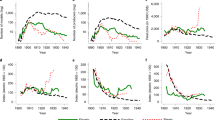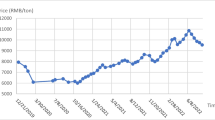Abstract
The purpose of this paper was to investigate the impact of household characteristics and preferences for Japanese cars on the demand for small cars in the United States. Two stage probit analysis was used to examine the impact of various explanatory variables on the purchase decision. The results indicated that preferences for Japanese cars, income, price and several household characteristics had a significant impact on the probability of purchasing a small car. The results of this study provide support for freer trade in automobiles and higher gasoline taxes as energy conservation strategies.
Zusammenfassung
Die Nachfrage nach Kleinwagen in USA: Implikationen für Strategien zur Energieeinsparung. Diese Untersuchung wollte herausfinden, wie sich Haushaltseigenschaften und Präferenzen für japanische Autos auf die Nachfrage nach Kleinwagen in den Vereinigten Staaten auswirken. Die Stichprobe umfa\te 367 Haushalte, die im Jahr 1986 ein neues Auto kauften. Davon kauften 141 Haushalte amerikanische Kleinwagen, 84 japanische Kleinwagen und 142 Haushalte kauften gro\e amerikanische Wagen. Eine zweistufige Probit-Analyse prüfte den Einflu\ der verschiedenen Erklärungsvariablen auf die Kaufentscheidung. Die Ergebnisse besagen im wesentlichen, da\ es die Präferenzen für japanische Autos, das Einkommen, der Preis und einige Haushaltseigenschaften sind, die einen signifikanten Einflu\ auf die Wahrscheinlichkeit eines Kleinwagenkaufs haben. Die Autoren sehen in den Ergebnissen eine Unterstützung für die Forderung nach Freihandel im Automobilsektor und nach höherer Besteuerung von Kraftstoffen als Strategien zur Energieeinsparung.
Similar content being viewed by others
References
Automotive News (selected years). Domestic car sales.
Big cars: Hail and farewell (1991).Consumer Reports, 56(1), 51.
Blomqvist, A. G., & Haessel, W. (1978). Small cars, large cars, and the price of gasoline.Econometrica, 11, 470–489.
Carlson, R. L. (1978). Seemingly unrelated regression and the demand for automobiles of different sizes, 1965–1975: A disaggregate market approach.Journal of Business, 51, 243–262.
Carlson, R. L., & Umble, M. M. (1980). Statistical demand functions for automobiles and their use for forecasting in an energy crisis.Journal of Business, 53, 193–204.
Crandall, R. W., Gruenspecht, H. K., Keeler, T. E., & Lave, L. B. (1986).Regulating the automobile. Washington, DC: The Brookings Institution.
Dardis, R., & Hrozencik, D. (1984). The impact of the economic environment and socio-economic characteristics on the purchase of small cars. In:Proceedings of the ACCI 30th Annual Conference, pp. 103–109. Columbia, MO: American Council on Consumer Interests.
Dardis, R., & Hrozencik, D. (1985). The impact of socio-economic variables and automobile stock characteristics on the purchase of new imported automobiles.Advances in Consumer Research, 12, 538–543.
Duncan, R. S. (1980). The effect of gasoline prices on automobile sales.American Economist, 24(1), 62–66.
Frequency of repair records, 1980–1985 (1986).Consumer Reports, 56(4), 248–262.
Freund, J. E., & Williams, F. J. (1977).Elementary business statistics. Englewood Cliffs, NJ: Prentice-Hall.
Greenlees, J. S. (1980). Gasoline prices and purchases of new automobiles.Southern Economic Journal, 47, 167–178.
Henderson, D. R. (1985). The economics of the fuel economy standards.Regulation, 9(1), 45–48.
Hensher, D. A., & Jackson, J. E. (1981).Applied discrete choice modeling. New York: Academic Press.
How to drive a hard bargain in a soft market (1990).Consumer Reports, 55(4), 213.
Kee, O. (1991). Personal communication. Washington, DC: U.S. Department of Transportation, National Highway Traffic Safety Administration.
Lave, C. A., & Bradley, J. (1980). Market share of imported cars: A model of geographic and demographic determinants.Transportation Research, 14 A, 379–387.
Lave, C. A., & Train, K. (1979). A disaggregate model of auto types choice.Transportation Research, 13 A, 1–9.
Maddala, G. S. (1983).Limited-dependent and qualitative variables in econometrics. Cambridge, MA: Cambridge University Press.
Mathews, J. (1991). Still on an energy binge.Washington Post, March 1, p. A15.
Peters, W. H. (1970). Using MCA to segment new car markets.Journal of Marketing Research, 7, 360–363.
Pindyck, R. S., & Rubinfeld, D. L. (1981).Econometric models and econometric forecasts. Second edition. NY: McGraw-Hill.
Quotas: A six year losing streak (1986).Consumer Reports, 51(4), 210.
Rowen, H. (1991). The President's addiction to oil imports.Washington Post, February 28, p. A19.
Samuelson, R. J. (1991). Just tinkering with energy.Washington Post, February 27, p. A25.
Schwartz, J., & Stone, J. (1987). New-car buyers.American Demographics, 9(4), 33–36.
Takacs, W. E., & Tanzer, E. P. (1986). Structural change in the demand for automobiles by size class.Quarterly Review of Economics and Business, 26(3), 48–57.
Tardiff, T. (1976). A note on the goodness of fit statistics for probit and logit models.Transportation, 5, 377–388.
Treece, J.B., & Melcher, R. S. (1990). Will Japan do to Europe what it did to Detroit?Business Week, May 7, pp. 52–53.
Tully, S. (1990). How Japan's autos push into Europe.Fortune, 122(1), 96–102.
Wetzel, J., & Hoffer, G. (1982). Consumer demand for automobiles: A disaggregated market approach.Journal of Consumer Research, 9, 195–199.
Will the auto glut choke Detroit P. (1988).Business Week, March 7, pp. 55–57.
Yates, B. (1983).The decline and fall of the American automobile industry. New York: Empire Books.
Author information
Authors and Affiliations
Rights and permissions
About this article
Cite this article
Dardis, R., Soberon-Ferrer, H. The demand for small cars in the United States: Implications for energy conservation strategies. J Consum Policy 15, 1–20 (1992). https://doi.org/10.1007/BF01016351
Issue Date:
DOI: https://doi.org/10.1007/BF01016351




